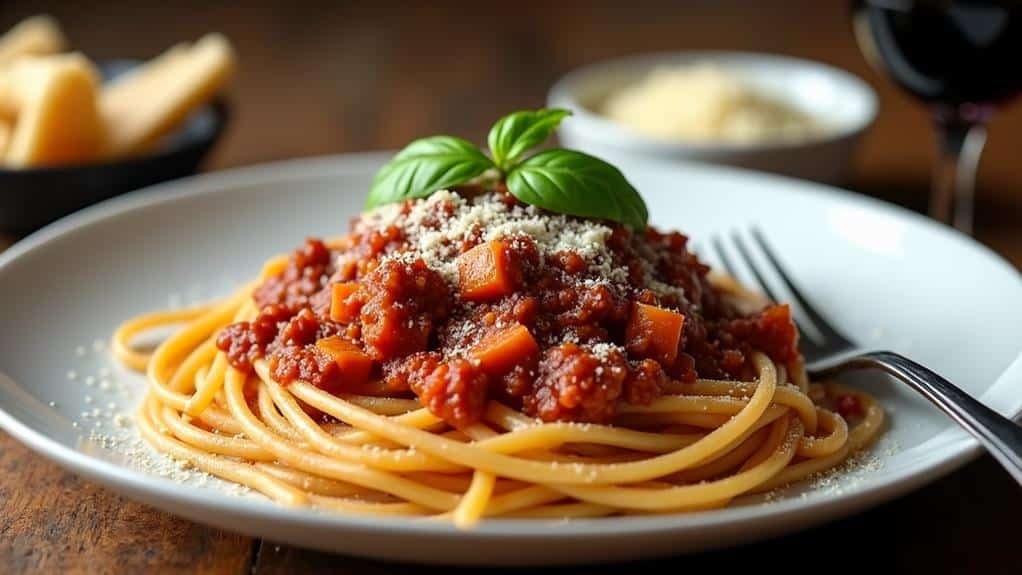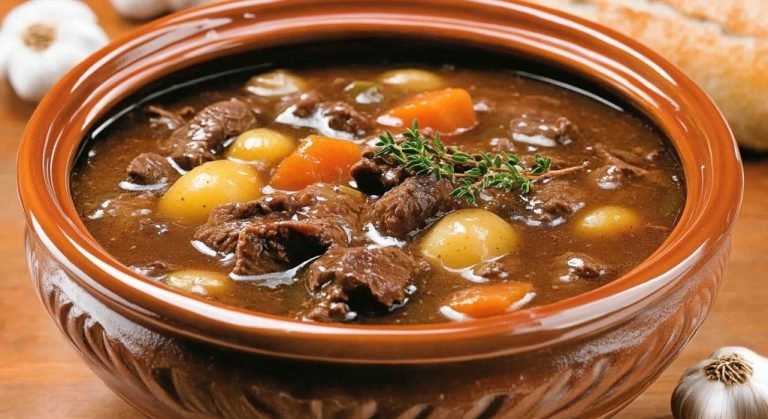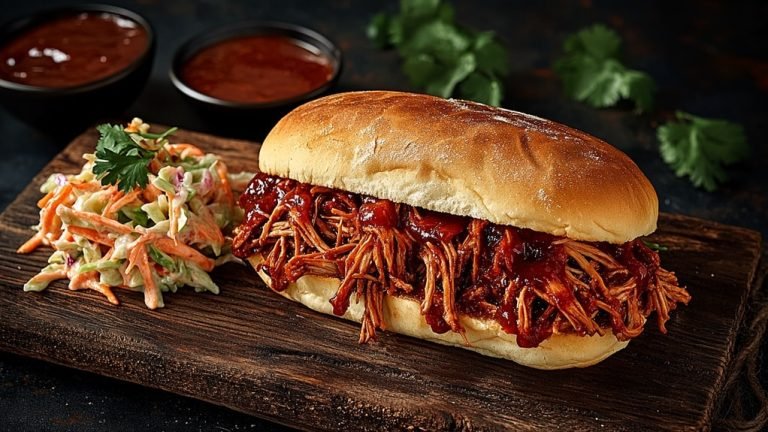Picture yourself in a cozy Italian trattoria, twirling a forkful of spaghetti coated in a rich, meaty sauce. That's the magic of Spaghetti Bolognese, a dish that's captured hearts and taste buds worldwide. You've probably enjoyed this comforting meal countless times, but there's more to it than meets the eye. From its humble origins in Bologna to its countless variations across the globe, Spaghetti Bolognese has a fascinating story to tell. And if you think you know everything about this beloved dish, you might be surprised by what you're about to discover.
Key Takeaways
- Spaghetti Bolognese combines al dente pasta with a rich, meaty sauce made from ground beef, tomatoes, and herbs.
- The dish originated as a fusion of Italian and international cuisines, evolving from the traditional ragù alla bolognese.
- Key ingredients include ground beef, tomatoes, red wine, beef broth, bay leaves, oregano, and spaghetti.
- Preparation involves browning beef, sautéing vegetables, and simmering the sauce for 1-1.5 hours to develop rich flavors.
- Spaghetti is cooked al dente and combined with the thickened sauce, creating a comforting and widely popular dish.
History
Two popular legends surround the origins of Spaghetti Bolognese. The first claims that it was created in the 1920s by Italian immigrants in America, who adapted their traditional meat sauce to local tastes. The second suggests it originated in Bologna, Italy, as a variation of the classic ragù alla bolognese. While both stories have their merits, you'll find that the truth is a bit more complex.
In reality, Spaghetti Bolognese as you know it today isn't a traditional Italian dish at all. It's a fusion of Italian and international cuisines that evolved over time.
The ragù alla bolognese, a meat-based sauce from Bologna, is traditionally served with tagliatelle or other broad, flat pasta. However, as Italian cuisine spread globally, chefs and home cooks began pairing this rich sauce with spaghetti, which was more widely available and popular outside of Italy.
You'll notice that the dish has become a staple in many countries, each adding its own twist. In the UK, it's often made with beef mince and tomato sauce, while in Italy, you'll find variations using different meats and less tomato.
Recipe
Spaghetti Bolognese is a classic Italian-inspired dish that has become a staple in many households around the world. This hearty meal combines al dente pasta with a rich, meaty sauce that's packed with flavor and satisfying textures.
While there are many variations of this beloved recipe, the core ingredients remain consistent: ground beef, tomatoes, herbs, and of course, spaghetti. The key to a great Bolognese lies in slowly simmering the sauce to allow the flavors to meld and develop, resulting in a deep, complex taste that perfectly complements the pasta.
- 500g ground beef
- 400g spaghetti
- 2 cans (400g each) crushed tomatoes
- 1 large onion, finely chopped
- 2 carrots, finely diced
- 2 celery stalks, finely diced
- 3 garlic cloves, minced
- 2 tbsp tomato paste
- 1 cup red wine
- 1 cup beef broth
- 2 bay leaves
- 1 tsp dried oregano
- Salt and pepper to taste
- Olive oil
- Grated Parmesan cheese for serving
To prepare the Bolognese, start by sautéing the onion, carrot, and celery in olive oil until softened. Add the garlic and cook for another minute. Brown the ground beef, then add the tomato paste, crushed tomatoes, red wine, beef broth, bay leaves, and oregano. Simmer the sauce for at least 1 hour, stirring occasionally.
Meanwhile, cook the spaghetti according to package instructions. Once the sauce has thickened and developed a rich flavor, season with salt and pepper. Serve the sauce over the cooked spaghetti and top with grated Parmesan cheese.
For the best results, use a heavy-bottomed pot or Dutch oven to cook the sauce, as this will help distribute heat evenly and prevent burning. Don't rush the simmering process, as this is crucial for developing the sauce's flavor. If you have time, consider making the sauce a day in advance and reheating it before serving, as this allows the flavors to intensify further.
Lastly, reserve some pasta cooking water to add to the sauce if it becomes too thick during the final heating.
Cooking Steps
To create the perfect Spaghetti Bolognese, you'll need to master a few key cooking steps that'll transform simple ingredients into a mouthwatering Italian classic.
As you embark on this culinary journey, you'll start by thoroughly browning the ground beef, then sautéing aromatic onions and garlic to build a flavorful base.
Once you've laid this foundation, you'll add ripe tomatoes and fragrant herbs, allowing the sauce to simmer and thicken while the pasta cooks to al dente perfection, resulting in a harmonious blend of textures and tastes that'll transport you straight to the heart of Bologna.
Step 1. Brown Ground Beef Thoroughly
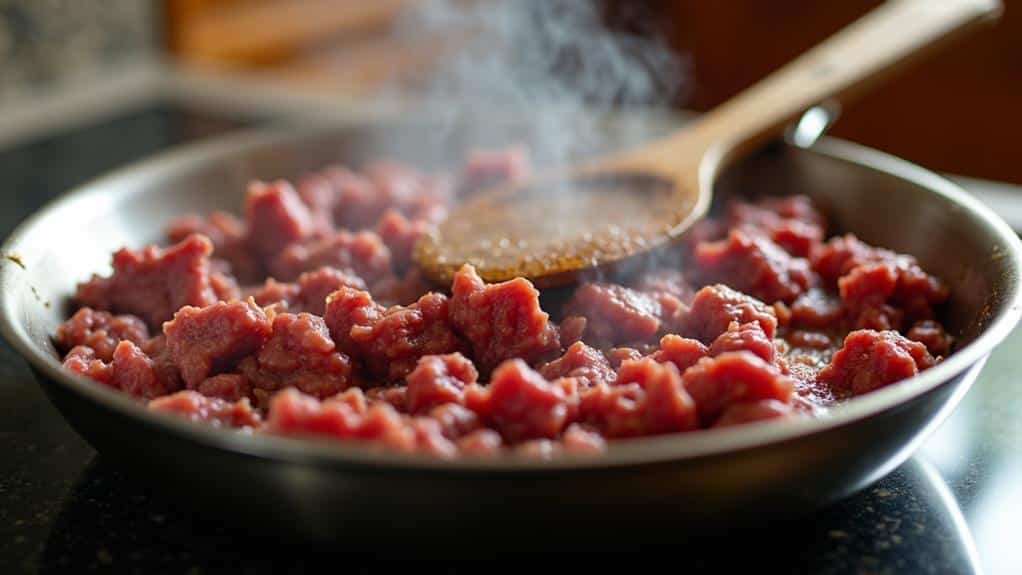
The most crucial step in preparing a delicious Bolognese sauce is properly browning the ground beef. You'll want to heat your pan over medium-high heat, adding a touch of oil to prevent sticking. Once the pan is hot, add the ground beef in small batches, ensuring it's not overcrowded. As the meat cooks, you'll hear a satisfying sizzle and see it start to change color.
Use a wooden spoon or spatula to break the beef into small pieces, stirring occasionally. You're aiming for a deep, golden-brown color on all sides, which will take about 8-10 minutes. This process, known as the Maillard reaction, is where the magic happens, creating rich, complex flavors that form the foundation of your sauce.
Don't be tempted to rush this step; patience is key. As the beef browns, you'll notice a mouthwatering aroma filling your kitchen. Once it's thoroughly cooked, drain any excess fat, leaving just enough to coat the bottom of the pan. This well-browned beef will give your Bolognese sauce that authentic, hearty flavor that's been beloved in Italian cuisine for centuries.
Step 2. Add Onions and Garlic
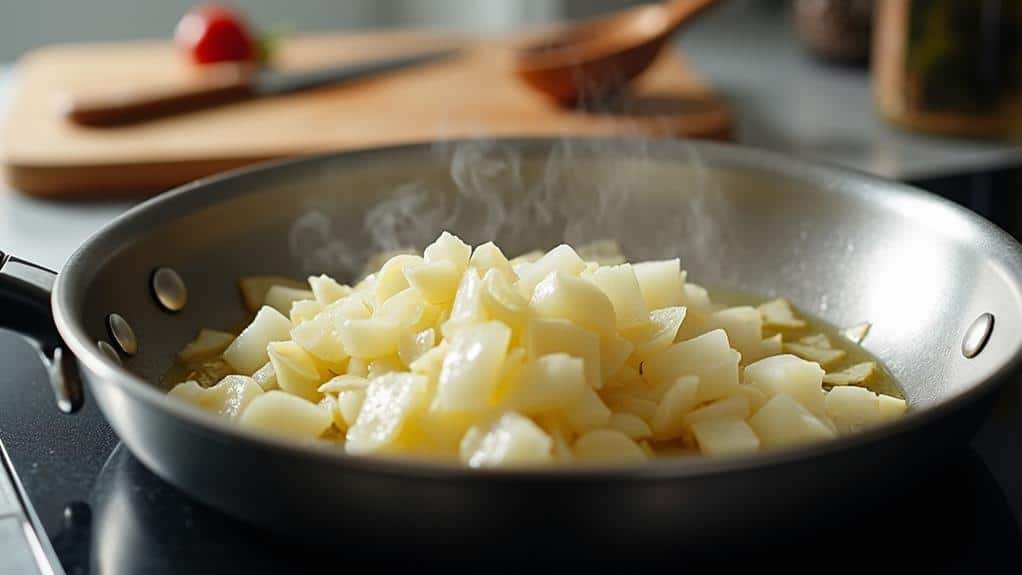
Once you've browned the beef to perfection, it's time to add layers of flavor with aromatic vegetables. Grab your chopping board and start by dicing a large onion into small, uniform pieces. The onion, a staple in Italian cuisine for centuries, will provide a sweet and savory base for your sauce.
Next, mince three to four cloves of garlic, which will infuse the dish with its pungent, earthy aroma. Heat a tablespoon of olive oil in the pan with the beef, then add the onions and garlic, stirring frequently to prevent burning. As you sauté these ingredients, you'll notice the kitchen filling with a mouthwatering fragrance that's sure to make your stomach growl.
Cook the onions until they're translucent and slightly caramelized, which should take about 5-7 minutes. This process, known as "sweating" the onions, releases their natural sugars and creates a depth of flavor that's essential to a good Bolognese sauce. Once the onions are soft and golden, and the garlic is fragrant but not browned, you're ready to move on to the next step in creating your delicious Spaghetti Bolognese.
Step 3. Add Tomatoes and Herbs
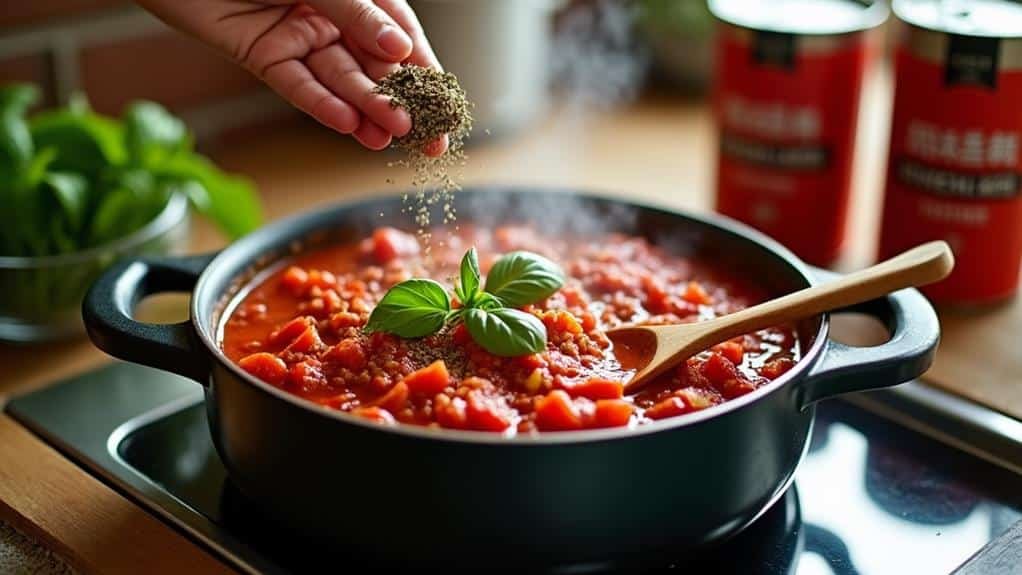
Vibrant tomatoes and fragrant herbs take center stage in this crucial step of creating your Bolognese sauce. As the onions and garlic soften, it's time to introduce the star ingredients that'll give your sauce its signature flavor and color.
Start by adding two 28-ounce cans of crushed tomatoes to the pot, stirring gently to combine with the sautéed vegetables. The tomatoes will bring a tangy sweetness and rich texture to your sauce, while also providing a beautiful red hue.
Next, it's time to add the herbs that'll elevate your Bolognese from good to exceptional. Sprinkle in a tablespoon of dried oregano and a handful of fresh basil leaves, torn into small pieces. These Mediterranean herbs have been used in Italian cooking for centuries, adding depth and complexity to the sauce.
As you stir in the herbs, you'll notice their aromatic oils releasing, filling your kitchen with an irresistible scent. Don't forget to season with salt and pepper to taste, enhancing the natural flavors of the tomatoes and herbs. Let the sauce simmer gently, allowing the flavors to meld and intensify over time.
Step 4. Simmer Sauce Until Thickened
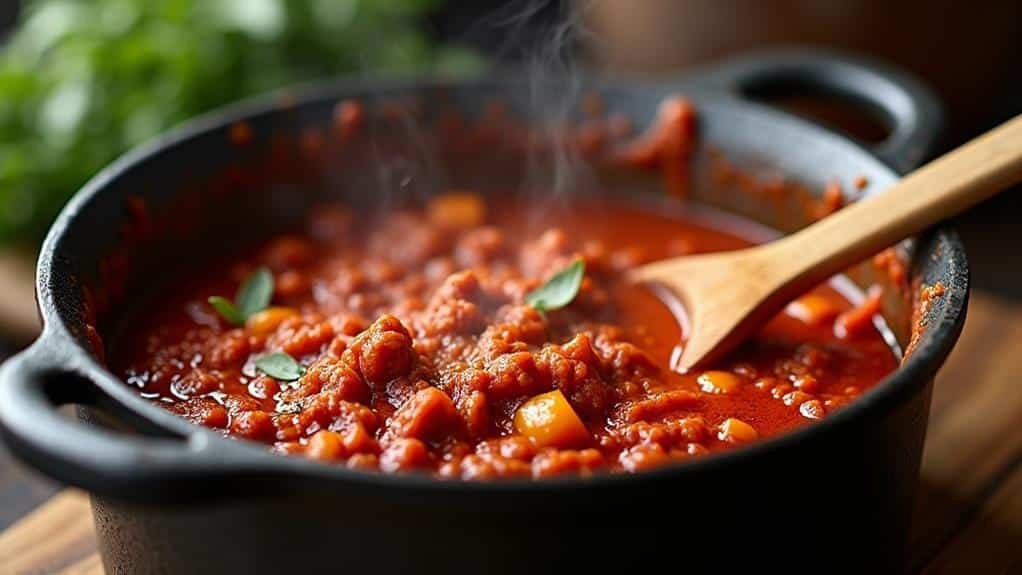
Simmering your Bolognese sauce is crucial for developing its rich flavor and achieving the perfect consistency. Once you've added the tomatoes and herbs, you'll want to reduce the heat to low and let the sauce simmer gently. This slow cooking process allows the flavors to meld together and intensify, creating a deep, complex taste that's characteristic of a true Bolognese.
As the sauce simmers, you'll notice it gradually thickening. Stir occasionally to prevent sticking, and keep an eye on the consistency. The goal is to achieve a sauce that's thick enough to coat the pasta but not so dense that it becomes paste-like.
This process typically takes about 1 to 1.5 hours, during which time the liquid will reduce and the flavors will concentrate. You'll know it's ready when the sauce has a rich, meaty aroma and clings to the back of a spoon. The tomatoes will have broken down, and the meat will be tender and infused with the flavors of the herbs and wine.
This patient approach to cooking is what transforms simple ingredients into the beloved Italian classic we know as Spaghetti Bolognese.
Step 5. Cook Pasta Until Al Dente
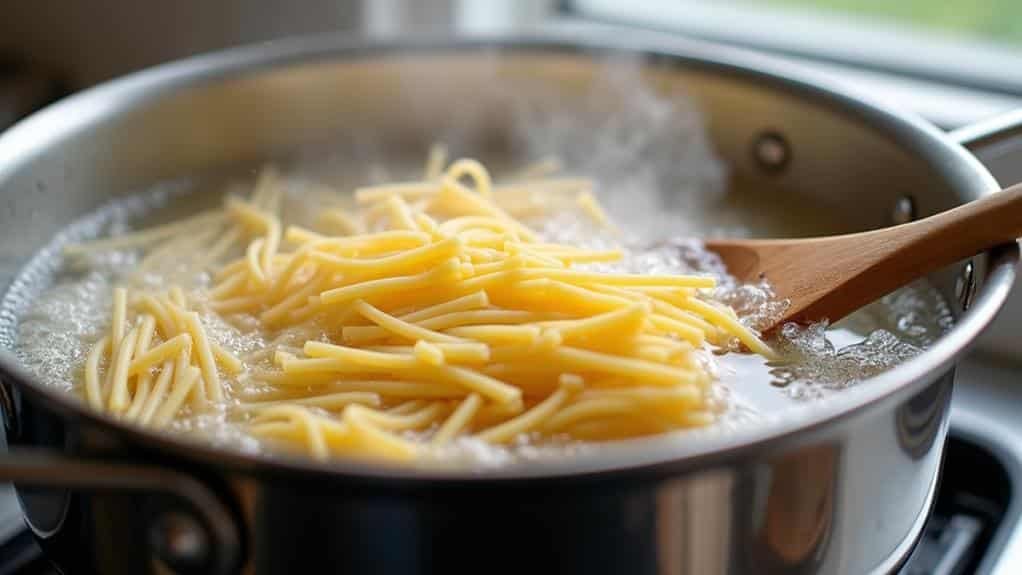
While your Bolognese sauce simmers, it's time to cook the pasta. Fill a large pot with water, about three-quarters full, and bring it to a rolling boil. Once the water's bubbling vigorously, add a generous pinch of salt – this will enhance the pasta's flavor. Carefully add your spaghetti, using long strands that are traditional for this dish. As the pasta softens, gently push it down into the water until it's fully submerged.
Cook the spaghetti according to the package instructions, but aim for "al dente," which means "to the tooth" in Italian. This texture, where the pasta is cooked but still firm when bitten, is crucial for authentic Italian pasta dishes.
To test for doneness, fish out a strand and bite into it – there should be a slight resistance at the center. It's better to slightly undercook than overcook, as the pasta will continue to soften slightly when mixed with the hot sauce.
Once it's ready, drain the pasta in a colander, but don't rinse it – the starchy coating helps the sauce cling to the noodles.
Final Thoughts
The aroma of a well-prepared Spaghetti Bolognese lingers long after the meal is over. As you've learned, crafting this classic Italian dish is an art that balances simplicity with depth of flavor.
You've mastered the rich, meaty sauce that simmers for hours, developing its complex taste, and paired it with perfectly cooked al dente pasta. Remember, the key to a great Bolognese lies in patience and quality ingredients. Don't rush the process; let the flavors meld and intensify over time.
While the traditional recipe calls for spaghetti, feel free to experiment with other pasta shapes like tagliatelle or pappardelle, which hold the sauce beautifully. As you serve your creation, take pride in knowing you've prepared a dish that has comforted generations of diners since its origins in Bologna, Italy.
The combination of tender ground meat, aromatic vegetables, and tomatoes, all clinging to each strand of pasta, creates a harmonious blend that's both satisfying and memorable. With practice, you'll find your own perfect balance of ingredients, making this timeless recipe uniquely yours.
Frequently Asked Questions
Is Spaghetti Bolognese Authentically Italian?
You'll find that spaghetti bolognese isn't authentically Italian. It's actually a dish that evolved outside of Italy. Italians traditionally serve their meat-based ragù with tagliatelle, not spaghetti. The authentic version differs significantly from what you're familiar with.
Can Vegetarian or Vegan Alternatives Be Used in Spaghetti Bolognese?
You can definitely create vegetarian or vegan versions of spaghetti bolognese. Try using plant-based meat alternatives, lentils, or mushrooms for texture. Don't forget to swap out cheese for vegan options if you're going dairy-free.
What Wine Pairs Well With Spaghetti Bolognese?
You'll want to pair a medium-bodied red wine with your dish. Try a Chianti, Sangiovese, or Barbera. They'll complement the tomato-based sauce nicely. If you prefer white, a dry Pinot Grigio can work too.
How Long Does Leftover Spaghetti Bolognese Stay Fresh in the Refrigerator?
You'll want to refrigerate your leftover spaghetti bolognese promptly. It'll stay fresh for 3-4 days when stored in an airtight container. Make sure you reheat it thoroughly before enjoying it again. Don't leave it out at room temperature.
Are There Any Regional Variations of Spaghetti Bolognese?
You'll find many regional variations of this dish. In Italy, you might encounter tagliatelle al ragù. Elsewhere, you'll see adaptations using different meats, spices, or pasta shapes. Each region adds its unique twist to the classic recipe.

